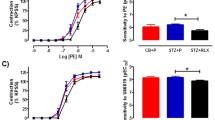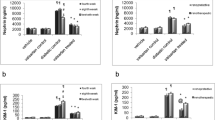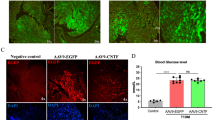Abstract
Vasoactive intestinal peptide (VIP) is a vasorelaxant peptide that addresses two receptor subtypes, VPAC1 and VPAC2. It stimulates insulin secretion and mediates anti-inflammatory effects and has been proposed for treatment of type 2 and autoimmune diabetes. In the heart, VIP is produced and released primarily by intrinsic neurons and improves cardiac perfusion and function. Here, we investigated the involvement of this system in the events underlying development of experimentally induced diabetic cardiomyopathy. Rats received a single streptozotocin injection, and cardiac VIP content [radioimmune assay (RIA)], expression of the VIP precursors VPAC1 and VPAC2 [real-time reverse transcription-polymerase chain reaction (RT-PCR)], and VPAC1 and VPAC2 tissue distribution (immunohistochemistry) were assessed 4, 8, and 16 weeks thereafter and compared with corresponding vehicle-treated controls. Cardiac neuropathy manifests progressively during the first 4 months of diabetes at the preproVIP mRNA and VIP peptide level and is accompanied by initial down-regulation of VPAC2 at one prime target of VIP-containing axons, i.e., smooth muscle cells of coronary arterioles. VPAC1 is expressed by macrophages. After initial changes that are specific for atria and ventricles, respectively, VPAC1 and VPAC2 expression return to control levels at 16 weeks despite ongoing loss of VIP. Given the cardioprotective role of the VIP signaling system, the persistence of receptors has therapeutic implications since it is the prerequisite for trials with VPAC2 agonists.







Similar content being viewed by others
References
Adeghate E, Ponery AS, Pallot DJ, Singh J (2001) Distribution of vasoactive intestinal polypeptide, neuropeptide-Y and substance P and their effects on insulin secretion from the in vitro pancreas of normal and diabetic rats. Peptides 22:99–107
Baron A, Monier D, Roatti A, Baretschi AJ (2001) Pituitary adenylate cyclase-activating polypeptide activates KATP current in rat atrial myocytes. Am J Physiol Heart Circ Physiol 280:1058–1065
Belai A, Lincoln J, Burnstock G (1987) Lack of release of vasoactive intestinal polypeptide and calcitonin gene-related peptide during electrical stimulation of enteric nerves in streptozotocin-diabetic rats. Gastroenterology 93:1034–1040
Belai A, Facer P, Bishop A, Polak JM, Burnstock G (1993) Effect of streptozotocin-diabetes on the level of VIP and mRNA in myenteric neurones. Neuroreport 4:291–294
Belai A, Calcutt NA, Carrington AL, Diemel LT, Tomlinson DR, Burnstock G (1996) Enteric neuropeptides in streptozotocin-diabetic rats; effects of insulin and aldose reductase inhibition. J Auton Nerv Syst 8:163–169
Bertrand G, Puech R, Maisonnasse Y, Bockaert J, Loubatieres-Mariani MM (1996) Comparative effects of PACAP and VIP on pancreatic endocrine secretions and vascular resistance in rat. Br J Pharmacol 117:764–770
DeHaven WI, Cuevas J (2002) Heterogeneity of pituitary adenylate cyclase-activating polypeptide and vasoactive intestinal polypeptide receptors in rat intrinsic cardiac neurons. Neurosci Lett 238:45–49
Delgado M, Abad C, Martinez C, Juarranz MG, Arranz A, Gomariz RP, Leceta J (2002) Vasoactive intestinal peptide in the immune system: potential therapeutic role in inflammatory and autoimmune disease. J Mol Med 80:16–24
Delgado M, Pozo D, Ganea D (2004) The significance of vasoactive intestinal peptide in immunomodulation. Pharmacol Rev 56:249–290
Dijkstra CD, Döpp EA, Joling P, Kraal G (1985) The heterogeneity of mononuclear phagocytes in lymphoid organs: distinct macrophage subpopulations in the rat recognized by monoclonal antibodies ED1, ED2 and ED3. Immunology 54:589–599
Filipsson K, Sundler F, Hannibal J, Ahren B (1998) PACAP and PACAP receptors in insulin producing tissues: localization and effects. Regul Pept 74:167–175
Harmar AJ, Arimura A, Gozes I, Journot L, Laburthe M, Pisegna JR, Rawlings SR, Robberecht P, Said SI, Sreedharan SP, Wank SA, Waschek JA (1998) International Union of Pharmacology. XVIII. Nomenclature of receptors for vasoactive intestinal peptide and pituitary adenylate cyclase-activating polypeptide. Pharmacol Rev 50:265–269
Henning RJ, Sawmiller DR (2001) Vasoactive intestinal peptide: cardiovascular effects. Cardiovasc Res 49:27–37
Inagaki N, Yoshida H, Mizuta M, Mizuno N, Fujii Y, Gonoi T, Miyazaki J, Seino S (1994) Cloning and functional characterization of a third pituitary adenylate cyclase-activating polypeptide receptor subtype expressed in insulin-secreting cells. Proc Natl Acad Sci U S A 91:2679–2683
Ishihara T, Shigemoto R, Mori K, Takahashi K, Nagata S (1992) Functional expression and tissue distribution of a novel receptor for vasoactive intestinal polypeptide. Neuron 8:811–819
Klimaschewski L (1997) VIP–a “very important peptide“ in the sympathetic nervous system? Anat Embryol 196:269–277
Kuncová J, Slavíková J, Reischig J (2003) Distribution of vasoactive intestinal polypeptide in the rat heart: effect of guanethidine and capsaicin. Ann Anat 185:153–161
McDonald TP, Dinnis DM, Morrison CF, Harmar AJ (1998) Desensitization of the human vasoactive intestinal peptide receptor (hVIP2/PACAP R): evidence for agonist-induced receptor. Ann NY Acad Sci 865:64–72
Miyata A, Sato K, Hino J, Tamakawa H, Matsuo H, Kangawa K (1998) Rat aortic smooth-muscle cell proliferation is bidirectionally regulated in a cell cycle-dependent manner via PACAP/VIP type 2 receptor. Ann NY Acad Sci 865:73–81
Nowak TV, Chey WW, Chang TM, Weisbruch JP, Fouquet G (1995) Effect of streptozotocin-induced diabetes mellitus on release of vasoactive intestinal polypeptide from rodent small intestine. Dig Dis Sci 40:828–836
Obata K, Itoh N, Okamoto H, Yanaihara C, Yanaihara N, Suzuki T (1981) Identification and processing of biosynthetic precursors to vasoactive intestinal polypeptide in human neuroblastoma cells. FEBS Lett 136:123–126
Onuoha GN, Alpar EK, Chukwulobelu R, Nicholls DP (1999) Distributions of VIP, substance P, neurokinin A and neurotensin in rat heart: an immunocytochemical study. Neuropeptides 33:19–25
Regalia J, Cai F, Helke C (2002) Streptozotocin-induced diabetes and the neurochemistry of vagal afferent neurons. Brain Res 938:7–14
Richardson RJ, Grkovic I, Anderson CR (2003) Immunohistochemical analysis of intracardiac ganglia of the rat heart. Cell Tissue Res 314:337–350
Said SI (1986) Vasoactive intestinal peptide. J Endocrinol Invest 9:191–200
Said SI, Mutt V (1970) Polypeptide with broad biological activity: isolation from small intestine. Science 169:1217–1218
Sano H, Miyata A, Horio T, Nishikimi T, Matsuo H, Kangawa K (2002) The effect of pituitary adenylate cyclase activating polypeptide on cultured rat cardiocytes as a cardioprotective factor. Regul Pept 109:107–113
Shetzline MA, Walkers JKL, Valenzano KJ, Premont RT (2002) Vasoactive intestinal polypeptide type-1 receptor regulation. J Biol Chem 277:25519–25526
Slavíková J (1997) Distribution of peptide-containing neurons in the developing rat right atrium, studied using immunofluorescence and confocal laser scanning. Neurochem Res 22:1013–1021
Steers WD, Mackway-Gerardi AM, Ciambotti J, de Groat WC (1994) Alterations in neural pathways to the urinary bladder of the rat in response to streptozotocin-induced diabetes. J Auton Nerv Syst 47:83–94
Straub SG, Sharp GW (1996) A wortmannin-sensitive signal transduction pathway is involved in the stimulation of insulin release by vasoactive intestinal polypeptide and pituitary adenylate cyclase-activating polypeptide. J Biol Chem 271:1660–1668
Tamakawa H, Miyata A, Satoh K, Miyake Y, Matsuo H, Arimura A, Kangawa K (1998) The augmentation of pituitary adenylate cyclase-activating polypeptide (PACAP) in streptozotocin-induced diabetic rats. Peptides 19:1497–1502
Troger J, Neyer S, Heufler C, Huemer H, Schmid E, Griesser U, Kralinger M, Kremser B, Baldissere I, Kieselbach G (2001) Substance P and vasoactive intestinal polypeptide in the streptozotocin-induced diabetic rat retina. Investig Ophthalmol Vis Sci 42:1045–1050
Tsutsumi M, Claus TH, Liang Y, Li Y, Yang L, Zhu J, Dela Cruz F, Peng X, Chen H, Yung SL, Hamren S, Livingston JN, Pan CQ (2002) A potent and highly selective VPAC2 agonist enhances glucose-induced insulin release and glucose disposal. A potential therapy for type 2 diabetes. Diabetes 51:1453–1460
Wei Y, Mojsov S (1996) Tissue specific expression of different human receptor types for pituitary adenylate cyclase activating polypeptide and vasoactive intestinal polypeptide: implications for their role in human physiology. J Neuroendocrinol 8:811–817
Weihe E, Reinecke M, Forssmann WG (1984) Distribution of vasoactive intestinal polypeptide-like immunoreactivity in the mammalian heart. Interrelation with neurotensin- and substance P-like immunoreactive nerves. Cell Tissue Res 236:527–540
Yada T, Sakurada M, Ihida K, Nakata M, Murata F, Arimura A, Kikuchi M (1994) Pituitary adenylate cyclase activating polypeptide is an extraordinarily potent intra-pancreatic regulator of insulin secretion from islet beta-cells. J Biol Chem 269:1290–1293
Yung SL, Dela Cruz F, Hamren S, Zhu J, Tsutsumi M, Bloom JW, Caudle M, Roczniak S, Todd T, Lemoine L, MacDougall M, Shanafelt AB, Pan CQ (2003) Generation of highly selective VPAC2 receptor agonists by high throughput mutagenesis of vasoactive intestinal peptide and pituitary adenylate cyclase-activating peptide. J Biol Chem 278:10273–10281
Ziegler D (1999) Cardiovascular autonomic neuropathy: clinical manifestations and measurements. Diabetes Rev 7:342–357
Zochodne DW, Verge VM, Cheng C, Sun H, Johnston J (2001) Does diabetes target ganglion neurones? Progressive sensory neurone involvement in long-term experimental diabetes. Brain 124:2319–2334
Acknowledgements
The authors thank Ms. P. Faulhammer, Ms. P. Freitag, Ms. G. Fuchs-Moll, Ms. J. Lodrová, Ms. K. Michael, Ms. T. Papadakis, Ms. K. Pícková, and Ms. S. Wiegand for skilful technical assistance. This study was supported by the Czech Science Foundation (GACR 305/01/0263, 305/03/D180), a governmental German-Czech cooperation grant (WTZ CZE 01/014), the German Research Foundation (DFG, Research Training Groups 534 and 1062), and a Young Scientist Award of the Faculty of Medicine, Justus Liebig University.
Author information
Authors and Affiliations
Corresponding author
Rights and permissions
About this article
Cite this article
Dvoráková, M.C., Pfeil, U., Kuncová, J. et al. Down-regulation of vasoactive intestinal peptide and altered expression of its receptors in rat diabetic cardiomyopathy. Cell Tissue Res 323, 383–393 (2006). https://doi.org/10.1007/s00441-005-0001-7
Received:
Accepted:
Published:
Issue Date:
DOI: https://doi.org/10.1007/s00441-005-0001-7




